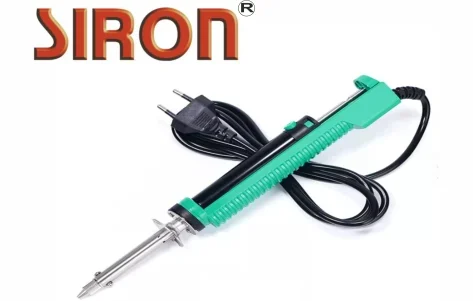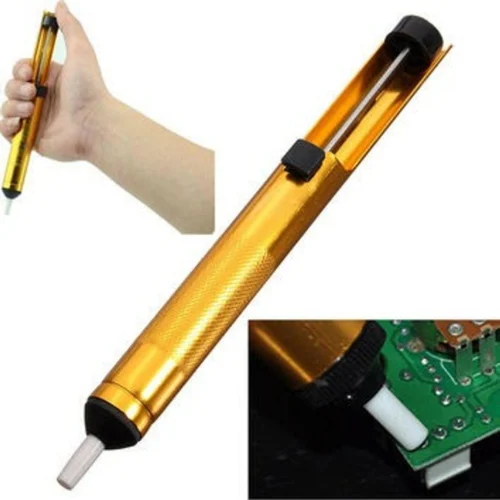Electrical Desoldering Pump: A Helping Hand for Delicate Repairs
An electrical desoldering pump, also known as a solder sucker, is a valuable tool for anyone working with electronics. It removes solder from circuit boards, allowing for the safe and efficient removal of electronic components.An electric desoldering pump is a handheld device typically consisting of a heating element, a plunger, and a vacuum chamber. The heating element resembles a soldering iron tip and is used to melt the solder you want to remove. The plunger creates suction within the vacuum chamber, which sucks up the molten solder when triggered.
Here’s a breakdown of the key components:
- Heating Element: This tip gets hot enough to melt solder, typically ranging from 30W to 40W in electric pumps.
- Plunger: Similar to a syringe, the plunger creates suction when pressed.
- Vacuum Chamber: This chamber holds the molten solder sucked up from the circuit board.
- Nozzle: The nozzle concentrates the suction onto the solder joint.
- Trigger: Pressing the trigger releases the vacuum, expelling the solder from the chamber.
- Power Source: Electric desoldering pumps require a power cord and plug into a wall outlet.
Specifications
| Feature | Specification |
|---|---|
| Power Consumption | 30W – 40W (typical) |
| Voltage | 110V or 220V (depending on region) |
| Heating Element Temperature | Adjustable (usually up to 450°C) |
| Vacuum Pressure | Not typically specified |
| Nozzle Sizes | May come with interchangeable nozzles |
Features
- Adjustable Temperature: Most electric desoldering pumps allow you to adjust the temperature of the heating element. This is crucial for working with different types of solder, as some have lower melting points than others.
- Multiple Nozzles: Some pumps come with interchangeable nozzles of various sizes. This allows for better control and access to different types of solder joints.
- Lightweight and Portable: Electric desoldering pumps are generally compact and lightweight, making them easy to maneuver and use in tight spaces.
- Faster Desoldering: Compared to solder wick, electric pumps offer a quicker and more efficient way to remove solder.
Applications
Electric desoldering pumps are a staple tool for various electronic tasks, including:
- Replacing Electronic Components: When a component needs to be replaced on a circuit board, the solder connections must be removed first. An electric desoldering pump allows for clean and precise removal of the solder, minimizing damage to the board and surrounding components.
- Desoldering Bridges: Solder bridges occur when excess solder accidentally connects two pads on a circuit board. An electric desoldering pump can quickly remove these unwanted connections.
- Repairing Circuit Boards: For troubleshooting and repairing faulty electronics, removing components and cleaning solder joints is often necessary. An electric desoldering pump streamlines this process.
- Desoldering Through-Hole Components: These components have pins that pass through holes on the circuit board and are soldered on the other side. Electric desoldering pumps are effective for removing these components.
Developments in Electric Desoldering Pumps
While the basic design of electric desoldering pumps has remained relatively unchanged, there have been some advancements in recent years:
- Digital Temperature Control: Some pumps now offer digital displays for precise temperature control.
- Automatic Shut-Off: This feature helps to prevent overheating and extends the life of the heating element.
- Desoldering Stations: These combine an electric desoldering pump with a soldering iron in a single unit, offering a convenient workstation for both soldering and desoldering tasks.
Instructions for Using an Electric Desoldering Pump
- Prepare the Workspace: Ensure you have a well-ventilated area and proper lighting.
- Power On and Pre-Heat: Plug in the desoldering pump and allow the heating element to reach the desired temperature according to the type of solder you’re working with.
- Position the Nozzle: Place the nozzle tip directly over the solder joint you want to remove.
- Melt the Solder: Briefly touch the heating element to the solder joint until it melts.
- Activate the Plunger: Press the trigger to create suction and remove the molten solder.
- Repeat: For larger solder joints, you may need to repeat steps 4 and 5 to remove all the solder.
- Clean the Nozzle: Regularly clean the nozzle with a damp cloth to prevent solder buildup.
- Power Off: When finished, allow the desoldering pump to cool down before turning it off and unplugging it.
Safety Tips:
- Always wear safety glasses to protect your eyes from flying solder
For more related products: Click here
For more services: Click here



Reviews
There are no reviews yet.